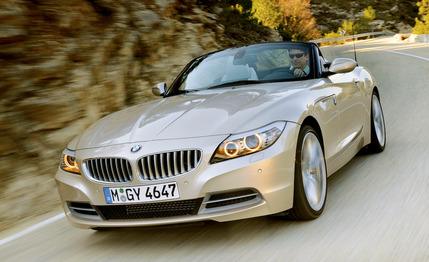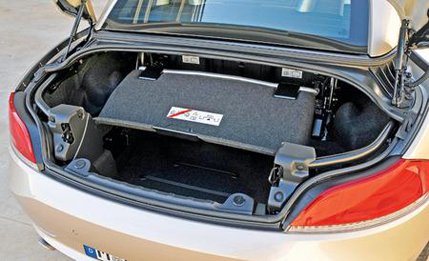
 Short Take Road Test
Short Take Road Test


The Z4 is part of a market segment long associated with thinning hair, sexual overcompensation, and other signs of a grievous midlife crisis. So it’s interesting to note that the designers of both the exterior and interior of BMW’s latest male-enhancement tool are women. These women really seem to understand us.
BMW identity means a twin-kidney grille and halo headlights, but it also means everyday usability to go with, as the Germans say, shportiness. We’ll get to the sporty part later. As for usability, the Z4 now comes with a folding aluminum roof that offers benefits beyond just looking good with the top up or down. BMW claims the solid roof allows for 40 percent more side-window glass and a 52-percent-larger rear window, as well as easier entry and exit. It also necessitates a longer trunk, which balances out the front and rear proportions better than in the previous Z4 and makes for a more practically shaped cargo hold (volume is up one cubic foot, to 10). It’s an effective visual trick: Though nearly identical in width and height to the old car, it looks much lower, wider, and sleeker. A 5.8-inch increase in length shows up mostly in the rear, but the new car retains an almost cartoonishly long nose. The extra length and the metal top come at a price of about 150 performance-dulling pounds.
That brings us to the sportiness, which will be slightly diminished in models with the base 3.0-liter engine. Previously the hotter of two regular Z4 engines and called the 3.0si, it, too, has been further enhanced—here via random word generator—and is now the sDrive30i, with output remaining at 255 horses. A more advantageous power-to-weight ratio can be found in the sDrive35i we recently drove. It has the twin-turbo 3.0-liter inline-six used throughout the BMW range and, as before, makes 300 horsepower. There’s enough room under the clamshell hood to install the M3’s V-8, but there’s no plan for an M version yet. One reason might be price: The turbo Z4 starts within two grand of the old M roadster, while the base Z4 costs about three grand more than the outgoing 3.0si.
Both engines come with a six-speed manual, and the base car has an optional six-speed automatic. A version of the seven-speed dual-clutch gearbox from the M3 is optional in the Z4 turbo model. The hardware is essentially the same, but the non-M version is called “sport automatic with double clutch” and doesn’t have all of the M3 tranny’s available settings. It still offers a launch-control mode, though.
The turbocharged engine adds another 200 pounds or so to the Z4, bringing the power-to-weight ratio right in line with the 335i’s. Our informal acceleration test yielded nearly identical times: 0 to 60 mph in 4.8 seconds and to 100 in 12 flat. Fuel economy should be similar to the 3-series as well. This new Z4’s exhaust note is louder than in other twin-turbo Bimmers and occasionally imparts the raspy metallic tone of the previous M3. We note that the strong powertrain is not equaled by the brakes, which faded after repeated stops.
Interior comfort has been vastly improved, and headroom is up nearly two inches. Stashes abound: an electronic parking brake makes room for storage space in the center console, plus there’s a real glove box and a small shelf behind the seats.
____________________________________________________


Despite a folding hardtop, the new Z4 has a larger, 10-cubic-foot trunk.
____________________________________________________
Our test car was equipped with the optional adaptive M suspension, which electronically adjusts the damper rates and offers three driver-selectable modes: normal, sport, and sport plus. The smooth and winding roads of southern Spain had us toggling between the two sport modes, but the normal setting should offer suitable compliance in North America. The Z4 keeps a flat cornering attitude in all three settings, and the neutral handling gives way progressively to gentle understeer at the limit. The electronically assisted steering has a responsive and direct feel but doesn’t offer much feedback from the road surface.
The isolated steering, combined with the rearward seating position, imparts a distinct cruising feel to the driving experience. The Z4, unlike the Z3 that spawned it, is not BMW’s interpretation of the British roadster or, for that matter, the Mazda Miata. Instead, the Z4 offers a satisfying combination of high performance and responsiveness with long-distance comfort. In other words, just the thing for that midlife crisis.